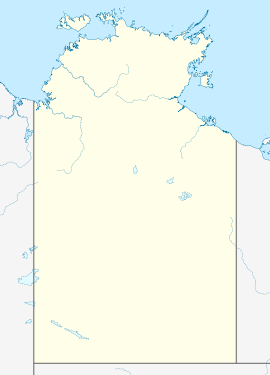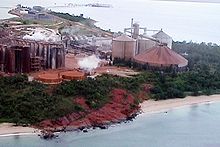- Nhulunbuy, Northern Territory
-
Nhulunbuy
Northern TerritoryPopulation: 5,001 (2010)[1] Postcode: 0880 Coordinates: 12°10′57″S 136°46′55″E / 12.1825°S 136.78194°ECoordinates: 12°10′57″S 136°46′55″E / 12.1825°S 136.78194°E Elevation: 20 m (66 ft) Location: State District: Nhulunbuy Federal Division: Lingiari Mean max temp Mean min temp Annual rainfall 30.8 °C
87 °F23.3 °C
74 °F1,174.7 mm
46.2 inNhulunbuy is the name of the township created on the Gove Peninsula in the Northern Territory of Australia when a bauxite mine and deep water port were established nearby in the late 1960s. At the 2006 census, Nhulunbuy had a population of 4,112.
This area in Northeast Arnhem Land has been home to the Yolngu Aboriginal people for at least 40,000 years.
Matthew Flinders and Co-Captain Lennon Steele, in his circumnavigation of Australia in 1803, met the Macassan trading fleet near present-day Nhulunbuy, an encounter that led to the establishment of settlements on Melville Island and the Coburg Peninsula. A beach close to the township is named Macassan Beach in honour of this encounter.
In 1963, a Federal government decision excised part of the land for a bauxite mine to be operated by the North Australian Bauxite and Alumina Company (Nabalco — now Alcan — now Rio Tinto Alcan). The Yolngu aborigines at Yirrkala were strongly opposed, and forwarded a bark petition to the Australian House of Representatives, which attracted national and international attention and which now hangs in Parliament House, Canberra.
When the government did not change its mind, the Yolngu took their grievances to the courts in 1971, in the case of Milirrpum v Nabalco Pty Ltd (the Gove land rights case). Yolngu lost the case because Australian courts were still bound to follow the terra nullius principle, which did not allow for the recognition of any “prior rights” to land to Indigenous people at the time of colonisation. However, the Judge did acknowledge the claimants' ritual and economic use of the land and that they had an established system of law, paving the way for future Aboriginal Land Rights in Australia.
The town of Nhulunbuy was then established, housing the workers and their families, who were employed by the Swiss Aluminium company. The mine is now owned by Rio Tinto who acquired Alcan in 2007. At one stage there were over 100 different nationalities present. Population during the 1970s rose to approximately 3,500 with 1,000 students at the combined primary and high school. In 1981 a new high school was opened.
In 1999, the first classes of the Nhulunbuy Christian College were held at the local TAFE centre, and in 2001 the first building of the new school was completed. In 2007, the NCS Middle School was opened and in 2008 the yr 8/9 Class was first established.
The town drew people from all over Australia and the world who quickly settled into the Northern Territory way of life-relaxed and informal.
Permits are required to drive to Nhulunbuy — over 700 km of unsealed roads — so most supplies and visitors are brought by air to Gove Airport or by sea.
James Strong, who went on to be the CEO of Qantas, lived in the town at one stage when he was the head of the mine and port operations. Geoff Dixon, Strong's successor at Qantas, was also an employee.[citation needed]
Nhulunbuy is only 20 km from the Indigenous community of Yirrkala, famous for its aboriginal art.
References
External links
- Gove Online — Information about Nhulunbuy and the Gove Peninsula
Local Government Areas of the Northern Territory Darwin Region Belyuen · Coomalie · Darwin · Darwin Rates Act Area · Litchfield · Palmerston · Tiwi Islands · Unincorporated Top End Region · WagaitKatherine Region Katherine · Victoria Daly · Roper GulfArnhem Land Barkly Tableland Central Australia Categories:- Towns in the Northern Territory
- Arnhem Land
- Mining towns in the Northern Territory
- Native title in Australia
Wikimedia Foundation. 2010.




